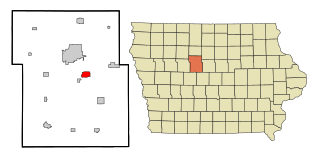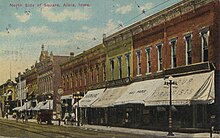
Monroe County is a county located in the south central part of the U.S. state of Iowa. In the early 20th century, it was a center of bituminous coal mining and in 1910 had a population of more than 25,000. As mining declined, people moved elsewhere for work. In the 2020 census, the population was 7,577. The county seat is Albia. The county, originally called Kishkekosh County after a famous chief of the Meskwaki, was renamed for James Monroe, fifth President of the United States

Carbon is a city in Douglas Township, Adams County, Iowa, United States. The population was 36 at the 2020 census.

Centerville is a city in and the county seat of Appanoose County, Iowa, United States. The population was 5,412 in the 2020 census, a decline from 5,924 in 2000. After the turn of the 20th century Centerville's coal mining industry attracted European immigrants from Sweden, Italy, Croatia, and Albania. Centerville is also home of the largest town square in the state of Iowa.

Exline is a city in Appanoose County, Iowa, United States. The population was 160 in the 2020 census, a decline from 191 in 2000.

Mystic is a city in Appanoose County, Iowa, United States. The population was 322 at the time of the 2020 census.

Numa is a city in Appanoose County, Iowa, United States. The population was 68 in the 2020 census, a decline from 109 in 2000.

Rathbun is a city in Appanoose County, Iowa, United States. The population was 43 at the time of the 2020 census.

Madrid is a city in Douglas Township, Boone County, Iowa, United States. The population was 2,802 at the time of the 2020 census. It is part of the Boone, Iowa Micropolitan Statistical Area, which is a part of the larger Ames-Boone, Iowa Combined Statistical Area.

Colfax is a city in Jasper County, Iowa, United States. Colfax is located approximately 24 miles east of Des Moines. The town was founded in 1866, and was named after Schuyler Colfax, vice president under Ulysses S. Grant. The population was 2,255 at the time of the 2020 census. Newton is the county seat; both were named after Revolutionary War soldiers.

Lucas is a city in Lucas County, Iowa, United States. The population was 172 at the time of the 2020 census.

Beacon is a city in Mahaska County, Iowa, United States. The population was 445 at the 2020 census.

Bussey is a city in southeast Marion County, Iowa, United States. The population was 387 at the time of the 2020 census.

Knoxville is a city in Marion County, Iowa, United States. The population was 7,595 at the time of the 2020 census, an increase from 7,313 in the 2010 census. It is the county seat of Marion County. Knoxville is home of the National Sprint Car Hall of Fame & Museum, located next to the famous Knoxville Raceway dirt track.

Marysville is a city in Marion County, Iowa, United States. The population was 44 at the time of the 2020 census.

Melcher-Dallas is a city in Marion County, Iowa, United States. The population was 1,195 at the time of the 2020 census.

Lovilia is a city in Monroe County, Iowa, United States. The population was 472 at the time of the 2020 census.

Seymour is a city in Wayne County, Iowa, United States. The population was 634 at the time of the 2020 census.

Coalville is a census-designated place (CDP) in Webster County, Iowa, United States. The population was 610 at the 2010 census. The community is located on U.S. Route 20 near Fort Dodge's large gypsum mines.

Lehigh is a city in Webster County, Iowa, United States. The population was 395 at the time of the 2020 census.

Eddyville is a city in Mahaska, Monroe, and Wapello counties in the U.S. state of Iowa. The population was 970 at the time of the 2020 census.

























